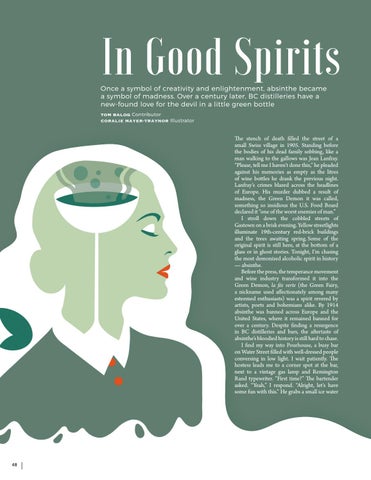In Good Spirits Once a symbol of creativity and enlightenment, absinthe became a symbol of madness. Over a century later, BC distilleries have a new-found love for the devil in a little green bottle TOM BALOG Contributor CORALIE MAYER-TRAYNOR Illustrator
The stench of death filled the street of a small Swiss village in 1905. Standing before the bodies of his dead family sobbing, like a man walking to the gallows was Jean Lanfray. “Please, tell me I haven’t done this,” he pleaded against his memories as empty as the litres of wine bottles he drank the previous night. Lanfray’s crimes blazed across the headlines of Europe. His murder dubbed a result of madness, the Green Demon it was called, something so insidious the U.S. Food Board declared it “one of the worst enemies of man.” I stroll down the cobbled streets of Gastown on a brisk evening. Yellow streetlights illuminate 19th-century red-brick buildings and the trees awaiting spring. Some of the original spirit is still here, at the bottom of a glass or in ghost stories. Tonight, I’m chasing the most demonized alcoholic spirit in history — absinthe. Before the press, the temperance movement and wine industry transformed it into the Green Demon, la fée verte (the Green Fairy, a nickname used affectionately among many esteemed enthusiasts) was a spirit revered by artists, poets and bohemians alike. By 1914 absinthe was banned across Europe and the United States, where it remained banned for over a century. Despite finding a resurgence in BC distilleries and bars, the aftertaste of absinthe’s bloodied history is still hard to chase. I find my way into Pourhouse, a busy bar on Water Street filled with well-dressed people conversing in low light. I wait patiently. The hostess leads me to a corner spot at the bar, next to a vintage gas lamp and Remington Rand typewriter. “First time?” The bartender asked. “Yeah,” I respond. “Alright, let's have some fun with this.” He grabs a small ice water
48
